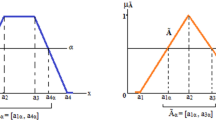Abstract
Product planning is one of four important processes in new product development (NPD) using quality function deployment (QFD). In order to model the process of product planning, the first problem to be solved is how to incorporate both qualitative and quantitative information regarding relationships between customer requirements and engineering characteristics, as well as among engineering characteristics, into the problem formulation. The inherent fuzziness of functional relationships in product planning makes the use of possibilistic regression justifiable. However, when linear programming in possibilistic regression analysis is used, some coefficients tend to become crisp because of the characteristic of linear programming. To tackle the problem, a non-linear programming based possibilistic regression approach is proposed, by which more diverse spread coefficients can be obtained than from a linear programming approach. An emulsification dynamite packing-machine design is used to illustrate the performance of the proposed approach.
Similar content being viewed by others
References
Akao Y (1990) Quality function deployment: integrating customer requirements into product design. Productivity Press, Cambridge, MA
Hauser JR, Clausing D (1988) The house of quality. Harvard Bus Rev 66(3):63–73
Wassermann GS (1993) On how to prioritize design requirements during the QFD planning process. Trans IIE 25(3):59–65
Moskowitz H, Kim KJ (1997) QFD optimizer: a novice friendly quality function deployment decision support system for optimizing product design. Comput Ind Eng 33:641–655
Fung RYK, Popplewell K, Xie J (1998) An intelligent hybrid system for customer requirements analysis and product attribute targets determination. Int J Prod Res 36(1):13–34
Tang J, Fung RYK, Xu B, Wang D (2002) A new approach to quality function deployment planning with financial consideration. Comput Oper Res 29(11):1447–1463
Park T, Kim KJ (1998) Determination of an optimal set of design requirements using house of quality. J Oper Manage 16:469–581
Tanaka H, Watada J (1988) Possibilistic linear systems and their application to the linear regression model. Fuzzy Sets Syst 27:275–289
Yang M, Liu H (2003) Fuzzy least-squares algorithms for interactive fuzzy linear regression models. Fuzzy Sets Syst 135:305–316
Kim KJ, Moskowitz H, Dhingra A, Evans G (2000) Fuzzy multicriteria models for quality function deployment. Eur J Oper Res 121:504–518
Yen KK, Ghoshary S, Roig G (1999) A linear regression model using triangular fuzzy number coefficients. Fuzzy Sets Syst 106:167–177
Chen Y, Tang J, Fung RYK, Ren Z (2004) Fuzzy regression-based mathematical programming model for quality function deployment. Int J Prod Res 42(5):1009–10027
Zhou M (1998) Fuzzy logic and optimization models for implementing QFD. Comput Ind Eng 35:237–240
Author information
Authors and Affiliations
Corresponding author
Rights and permissions
About this article
Cite this article
Chen, Y., Chen, L. A non-linear possibilistic regression approach to model functional relationships in product planning. Int J Adv Manuf Technol 28, 1175–1181 (2006). https://doi.org/10.1007/s00170-004-2466-z
Received:
Accepted:
Published:
Issue Date:
DOI: https://doi.org/10.1007/s00170-004-2466-z




